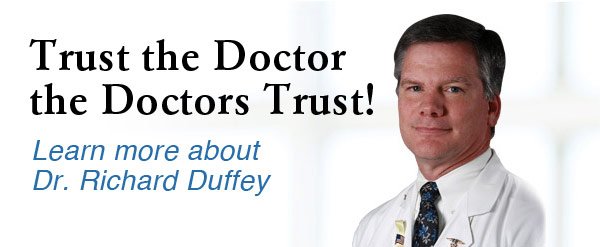What is LASIK?
The most important questions regarding LASIK Laser Vision Correction are:
- Who is my surgeon?
- Am I the perfect candidate?
- Does my surgeon use the best and most up-to-date technology?
These are the most important questions to have answered, and we have you covered each step of the way.
- Dr. Duffey is one of the most trusted LASIK surgeons in the country and has taught vision correction to many surgeons throughout the U.S. and internationally.
- With more than 25 years experience with LASIK since its introduction to the U.S. in 1995, he has performed LASIK on hundreds of doctors right here in Mobile and around the country.
Trust the Doctor the Doctors Trust
- Dr. Duffey is a leader in the LASIK field, speaking at national and international LASIK meetings and has written extensively on The U.S.Trends in Refractive Surgery since 1996.
We are excited to discuss your visual needs and goals with a FREE office screening or seminar.
Laser Assisted in-Situ Keratomileusis (LASIK)


 The Excimer Laser was introduced in the United States and received limited FDA approval in 1995. By changing the shape of the cornea, the patient's refractive error, whether it is nearsightedness (myopia), farsightedness (hyperopia), or astigmatism, can be corrected. LASIK utilizes the excimer laser to reshape the cornea beneath its surface after a superficial cornea flap is fashioned using either a femtosecond laser or a modern manual microkeratome. Both make cornea flaps of very high quality and consistency approximately one hundred microns in thickness. The flap is retracted and the excimer laser energy is applied beneath the flap to the cornea stroma for reshaping. The accuracy of the procedure is matched only by photorefractive keratectomy (PRK).
The Excimer Laser was introduced in the United States and received limited FDA approval in 1995. By changing the shape of the cornea, the patient's refractive error, whether it is nearsightedness (myopia), farsightedness (hyperopia), or astigmatism, can be corrected. LASIK utilizes the excimer laser to reshape the cornea beneath its surface after a superficial cornea flap is fashioned using either a femtosecond laser or a modern manual microkeratome. Both make cornea flaps of very high quality and consistency approximately one hundred microns in thickness. The flap is retracted and the excimer laser energy is applied beneath the flap to the cornea stroma for reshaping. The accuracy of the procedure is matched only by photorefractive keratectomy (PRK).
The key to success to laser vision correction and specifically LASIK is thorough preoperative testing, unsurpassed laser vision technology, and precise surgery by your laser surgeon. Extensive preoperative testing is done by Dr. Duffey to determine the candidacy of a patient before surgery can be scheduled. On the day of surgery, LASIK takes about twenty minutes for completion of both eyes with the actual laser component lasting between fifteen to thirty seconds per eye. The excimer laser reshapes the cornea by removing a quarter of a micron of tissue (that is one-four thousandth of a millimeter!) with each pulse. LASIK is best known for its very rapid healing response. After surgery, the patient is brought home for a three-and-a-half hour nap. Upon returning to normal activities later the same day, vision will be greatly improved and comfort restored. LASIK is performed simply with numbing eye drops and oral Xanax. Over ninety-nine percent of Dr. Duffey's patients are back legally driving a car the following morning after LASIK surgery and returning to a normal work schedule that first day. A topical antibiotic and a topical anti-inflammatory drop are used four times a day for one week following the surgery.

MYOPIA
(Nearsightedness)
Myopia or nearsightedness occurs when light rays are focused in front of the retina instead of directly on the retina.
ASTIGMATISM
Regular astigmatism occurs when light rays are focused at more than one point on the retina.
HYPEROPIA
(Farsightedness)
Hyperopia or farsightedness occurs when light rays are focused behind, rather than on, the retina.
LASIK
(Laser in-Situ Keratomileusis)
The excimer laser removes microscopic layers of corneal tissue to change its shape, allowing light rays to focus directly on the retina.
Laser Vision Correction (LASIK and PRK or Advanced Surface Ablation) is intended to correct eyesight to a level similar to that provided by eyeglasses or contact lenses without the inconvenience of these optical appliances and aids. As with all eye surgery, there is risk associated with laser vision correction surgery including, but not limited to, dry eye symptoms, visual glare and haloes, and even loss of vision.

